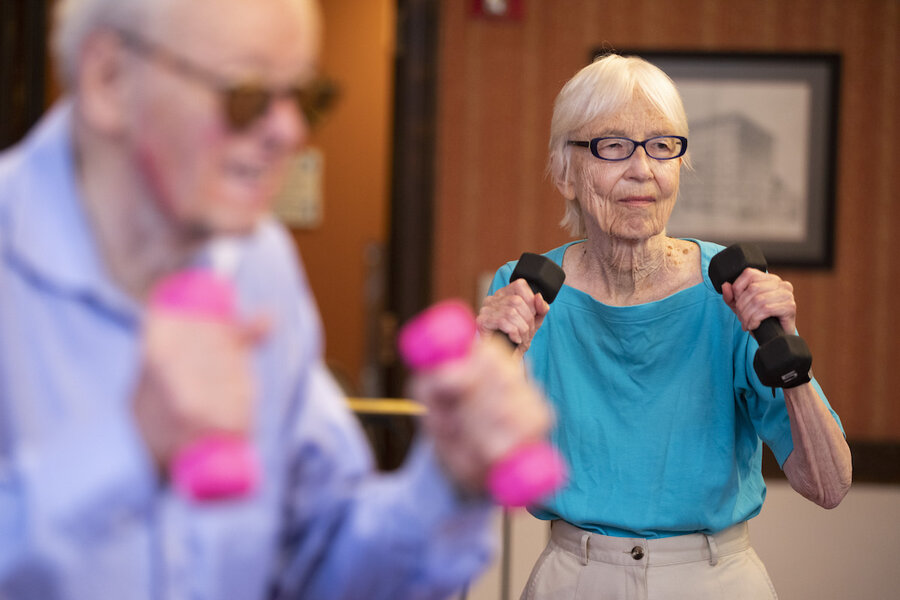Later life, on their own terms: How more seniors are staying at home
Loading...
| Boston
As she neared retirement in the late 1990s, Boston resident Susan McWhinney-Morse wasn’t satisfied with popular options for life after retirement.
“The prevailing attitude for people who retired was to move to Florida, to Arizona, to what were then brand-new continuing-care retirement communities where we could be safe, cared for, with other people like us – that whole concept of what I call ‘warehousing the elderly,’” she says. “But we happened to live in the city we loved, in houses we loved, and we felt that the concept of moving made absolutely no sense to us.”
Ms. McWhinney-Morse wanted to continue to live with dignity in her own home, but she anticipated that she might eventually need assistance. So she and 11 Boston-based friends decided to band together. Beacon Hill Village, which they formed in 2002, is about “knowing somebody has your back,” Ms. McWhinney-Morse says.
Why We Wrote This
Wanted: Innovation for older adults. More Americans are aging in place with living arrangements that are more satisfying, which highlights affordability concerns and the need for solutions that address safety.
The extensive “village” movement it has since spawned is part of a growing number of community-based efforts to meet the needs and preferences of older adults through the sharing economy.
Spanning six countries and 47 U.S. states, the 250 villages and the 130 in development differ in the kinds of communities they serve and how they serve them. But they share a central principle – what Ms. McWhinney-Morse calls the “secret sauce”: an interdependent community that comes together, with the help of a small coordinating staff, in pursuit of healthy, fulfilling lives.
“You can really get some shared savings on those sorts of economies, but it’s also again for fun things – to really live with age and thrive,” says Kathy Black, a professor of aging studies and social work at the University of South Florida Sarasota-Manatee.
More Americans age 67 or older are “aging in place,” or staying in their homes, longer than previous generations have, a February study by mortgage lender Freddie Mac shows.
Maintaining a sense of place and community helps prevent feelings of loneliness in older adults, experts say, leading to greater well-being. Three out of 4 Americans over the age of 50 want to stay in their current residence as long as possible, a 2018 AARP survey shows.
But remaining at home can present new challenges, such as the increased need for day-to-day assistance and mobility-enhancing home modifications.
Technological advancements like activity-monitoring sensors and automated medication dispensers enhance home safety. The market for aging technology will more than triple by 2022, up to $30 billion, according to projections from the Consumer Technology Association.
Client-oriented platforms also provide long-term solutions. Online roommate-matching services such as Silvernest – which has made 40,000 matches across all 50 states – find housemates for seniors. Another company, Nesterly, focuses on intergenerational home sharing, often pairing a young adult struggling to find a place with a senior seeking help with household chores.
“There are social and financial [advantages] – real health benefits from having somebody else there,” Dr. Black says.
At Beacon Hill Village, those connections come when members form affinity groups, which meet regularly for recreational activities. Ms. McWhinney-Morse remembers that when another woman had difficulty walking after a fall, the affinity group she belonged to sprang into action. Within two hours, three couples had shown up at her door. They helped lower her bed, bought groceries for her, and eventually found her a new apartment.
Aging in place is not a one-size-fits-all solution, Dr. Black says. More needs to be done to accommodate an older population with varying ranges of wealth, health, and even age, according to Laura Gitlin, gerontologist and dean of the College of Nursing and Health Professions at Drexel University in Philadelphia.
But Beacon Hill Village made an effort to include the 20% of the neighborhood living at or below the poverty line, Ms. McWhinney-Morse says. Annual membership fees are $675 for an individual and $975 for a household, but prospective members can apply for reduced fees of $110 and $160, respectively. They also receive stipends for social activities.
Fewer than 5% of U.S. homes are universally designed, or built to be accessible to people regardless of age and disability, according to Dr. Black. Housing is often overlooked as an aspect of wellness, Dr. Gitlin says, but continued innovation can help meet communities’ needs for suitable and affordable housing solutions.
“We need many more housing solutions that build in smart technologies for monitoring, for reminders, for making homes safer, [for] having people better connected,” she says. “And we do have that capacity. We don’t have the financial model for it. And we haven’t put it together so that it can be on a scale that everybody has access.”






